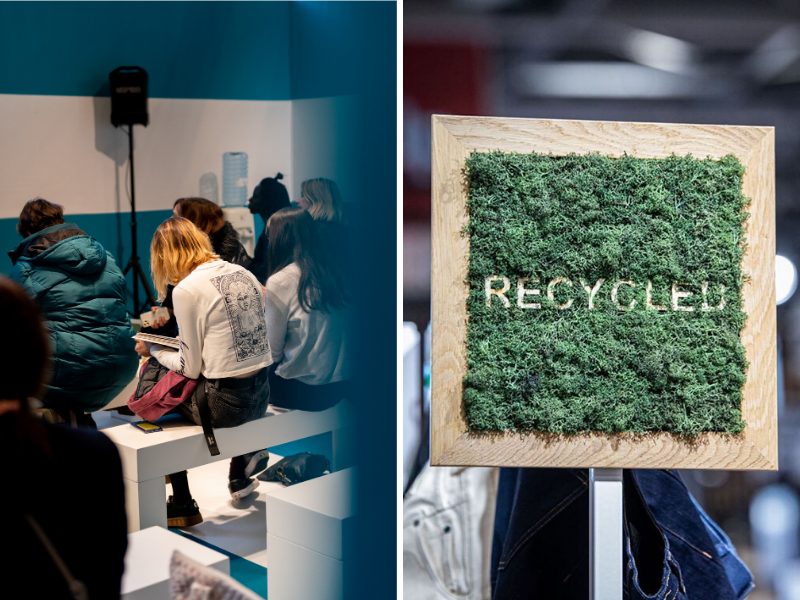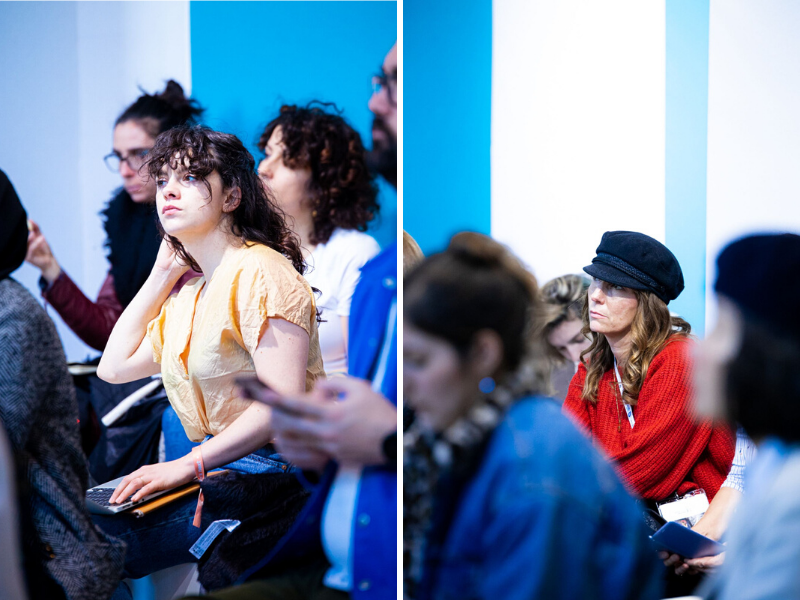Meeting with Liya Korjova, CSR and Éco Design expert
How do we reconcile the challenges of an inherently perishable industry with the new imperatives of sustainability? How do you integrate CSR into the value chain of your business?
Be great instead of big
Where to start? Liya Korjova, our CSR and Eco Design expert, answered these questions during one of the Who’s Next masterclasses held last January.
 In recent years, fashion has been in transition: economic, digital and ecological. A transition as plural and ‘slow’ as the model it covets: sustainability. The repetition of crises and the ecological imperative have triggered an awakening of consciousness. Today, a new wave of brands and creators represent a conscious and responsible vision of the fashion industry. In 2020, design must increasingly be in line with respect for environmental standards and human rights. The principle of transparency has become the foundation of a new industry which wants to act now. To ensure that these new commitments are respected, the European Commission has implemented CSR: Corporate Social Responsibility.So, what exactly is CSR? According to the French Government’s website, it is, “The voluntary integration by businesses of these new social and environmental responsibilities which can have a positive impact on society at the same time as promoting an economically viable model.” CSR is defined by seven areas of commitment: human rights, labour relations and working conditions, the environment, fair practices, and consumer, community and local development issues. Although still in the minority for the moment, these expanding principles will eventually become key factors in the viability of a business. In the future, in order to be desirable, fashion will have to be responsible. This ecological and social transition therefore seems inevitable, following decades of a race to produce according to a linear model which has now run out of steam. The popularity of the ‘take, make, dispose’ model is now dwindling: is the golden age of mindless consumerism therefore over? Nothing is less certain. If the fashion industry is to successfully undergo this transition and make a go of sustainability, groups, brands and consumers must commit themselves today, by relying on different models.In the 90s, the entrepreneur and sustainable economy activist, John Elkington, introduced the ‘triple bottom line’ concept - the ‘triple P’: person, planet, profit. It refers to the ‘bottom line’, ie. the ‘net result’ of a business, which it opposes by proposing an evaluation of entrepreneurial performance under a new, sustainable prism by relying on three perspectives; the social, the environmental and the economic. The concept of John Elkington, cofounder of the first British sustainable development strategy consulting firm, thus introduces the transposition of the concept of sustainable development in business. He proposes an analysis based on the cycles of nature and Lavoisier’s principle, according to which: “nothing is lost, nothing is created, everything is transformed.” This new vision of sustainable entrepreneurship therefore proposes to reconcile the human, environment and economy.
In recent years, fashion has been in transition: economic, digital and ecological. A transition as plural and ‘slow’ as the model it covets: sustainability. The repetition of crises and the ecological imperative have triggered an awakening of consciousness. Today, a new wave of brands and creators represent a conscious and responsible vision of the fashion industry. In 2020, design must increasingly be in line with respect for environmental standards and human rights. The principle of transparency has become the foundation of a new industry which wants to act now. To ensure that these new commitments are respected, the European Commission has implemented CSR: Corporate Social Responsibility.So, what exactly is CSR? According to the French Government’s website, it is, “The voluntary integration by businesses of these new social and environmental responsibilities which can have a positive impact on society at the same time as promoting an economically viable model.” CSR is defined by seven areas of commitment: human rights, labour relations and working conditions, the environment, fair practices, and consumer, community and local development issues. Although still in the minority for the moment, these expanding principles will eventually become key factors in the viability of a business. In the future, in order to be desirable, fashion will have to be responsible. This ecological and social transition therefore seems inevitable, following decades of a race to produce according to a linear model which has now run out of steam. The popularity of the ‘take, make, dispose’ model is now dwindling: is the golden age of mindless consumerism therefore over? Nothing is less certain. If the fashion industry is to successfully undergo this transition and make a go of sustainability, groups, brands and consumers must commit themselves today, by relying on different models.In the 90s, the entrepreneur and sustainable economy activist, John Elkington, introduced the ‘triple bottom line’ concept - the ‘triple P’: person, planet, profit. It refers to the ‘bottom line’, ie. the ‘net result’ of a business, which it opposes by proposing an evaluation of entrepreneurial performance under a new, sustainable prism by relying on three perspectives; the social, the environmental and the economic. The concept of John Elkington, cofounder of the first British sustainable development strategy consulting firm, thus introduces the transposition of the concept of sustainable development in business. He proposes an analysis based on the cycles of nature and Lavoisier’s principle, according to which: “nothing is lost, nothing is created, everything is transformed.” This new vision of sustainable entrepreneurship therefore proposes to reconcile the human, environment and economy. Before, thanks to its extremely well-established image, a brand would been able to make an icon of its simple white T-shirt. A textbook example. Its impact on the imagination remains engraved in the memory of consumers, and sometimes even over several generations.To make a lasting commitment to the transition towards sustainability, it is therefore essential to draw up a code of ethics for your brand. You can also map out the CSR issues in the life cycle of your products or services and collect data in order to best assess the CSR risks. Every transition needs a dedicated plan of action. The idea here being to find alternatives, such as using more responsible materials or looking for local manufacturers… Once these steps are implemented, visibility and the act of transparency are essential, in order to make the most of your actions and position yourself as a player in this transition.Today, brands must offer a real experience: an unforgettable moment created by a brand itself. In order to exist sustainably, it must bring its concept to life, making full use of communication tools and the principle of transparency. Fashion today no longer only sells objects, but a commitment, a vision, values. Almost a modus vivendi, sometimes even a way of life, as can be seen with the designer, Simon Porte Jacquemus. “The times push us to become giants,” concludes Liya Korjova. But maybe, instead, it’s time to: “be great instead of big.”
Before, thanks to its extremely well-established image, a brand would been able to make an icon of its simple white T-shirt. A textbook example. Its impact on the imagination remains engraved in the memory of consumers, and sometimes even over several generations.To make a lasting commitment to the transition towards sustainability, it is therefore essential to draw up a code of ethics for your brand. You can also map out the CSR issues in the life cycle of your products or services and collect data in order to best assess the CSR risks. Every transition needs a dedicated plan of action. The idea here being to find alternatives, such as using more responsible materials or looking for local manufacturers… Once these steps are implemented, visibility and the act of transparency are essential, in order to make the most of your actions and position yourself as a player in this transition.Today, brands must offer a real experience: an unforgettable moment created by a brand itself. In order to exist sustainably, it must bring its concept to life, making full use of communication tools and the principle of transparency. Fashion today no longer only sells objects, but a commitment, a vision, values. Almost a modus vivendi, sometimes even a way of life, as can be seen with the designer, Simon Porte Jacquemus. “The times push us to become giants,” concludes Liya Korjova. But maybe, instead, it’s time to: “be great instead of big.”